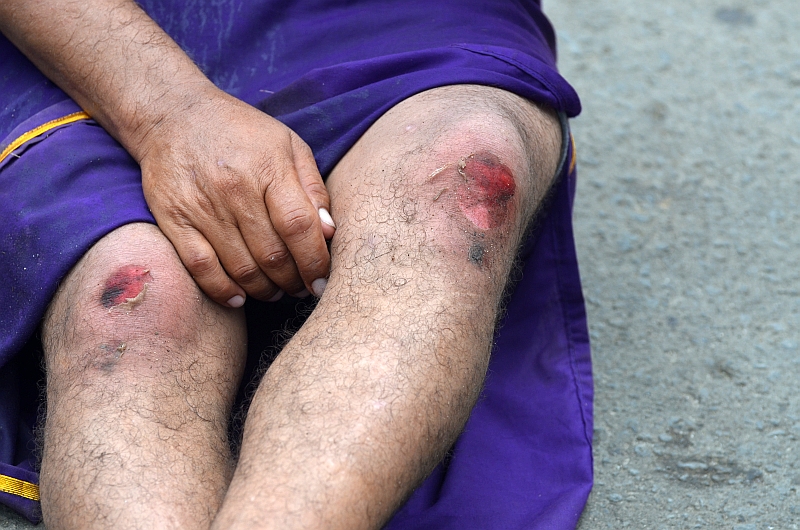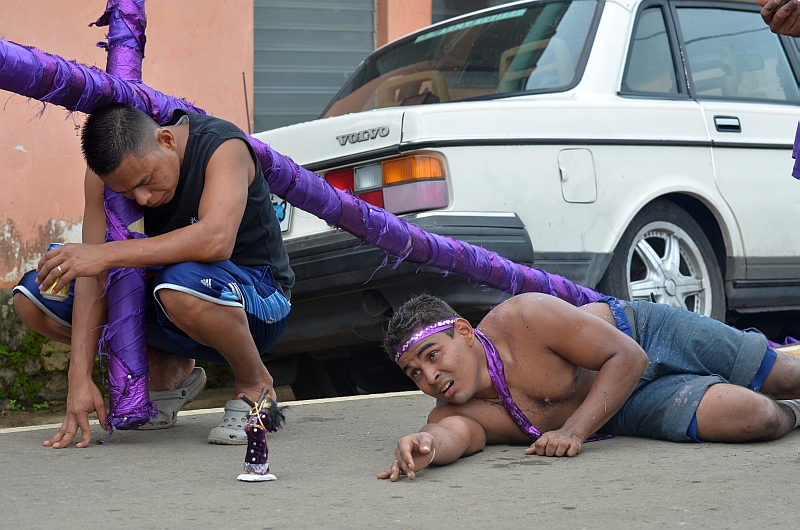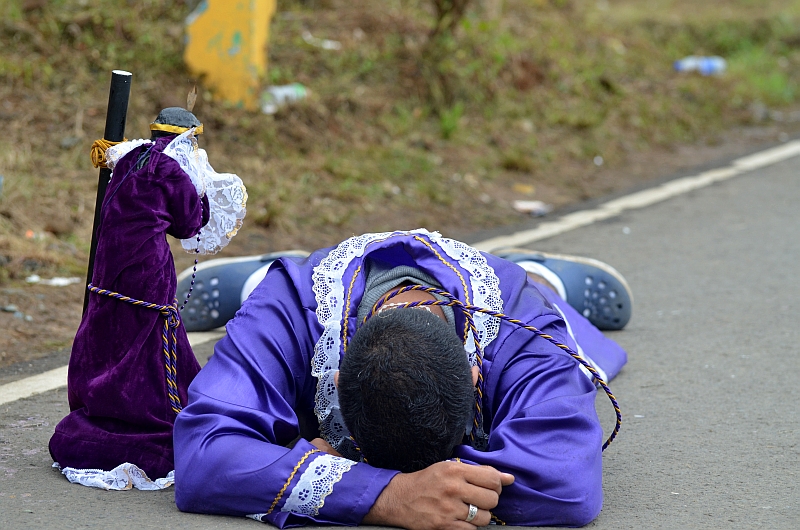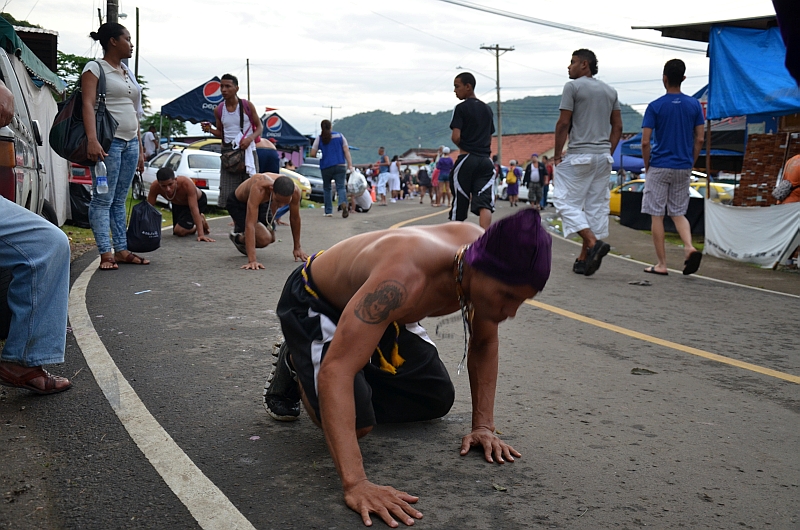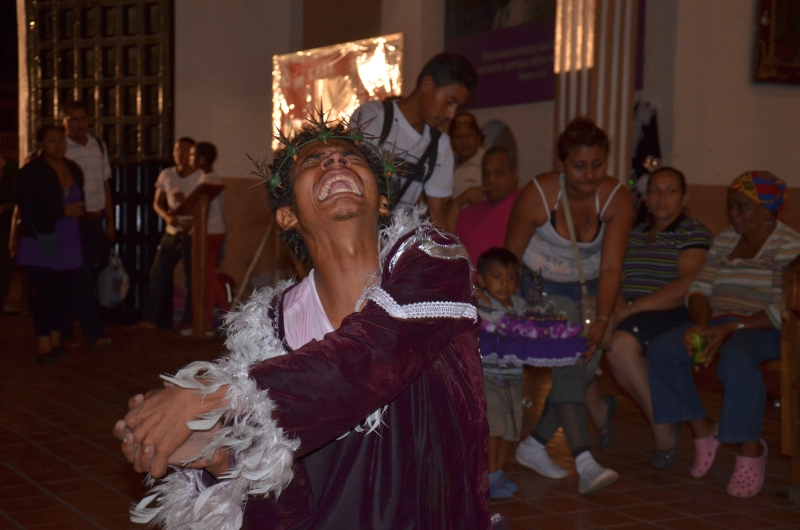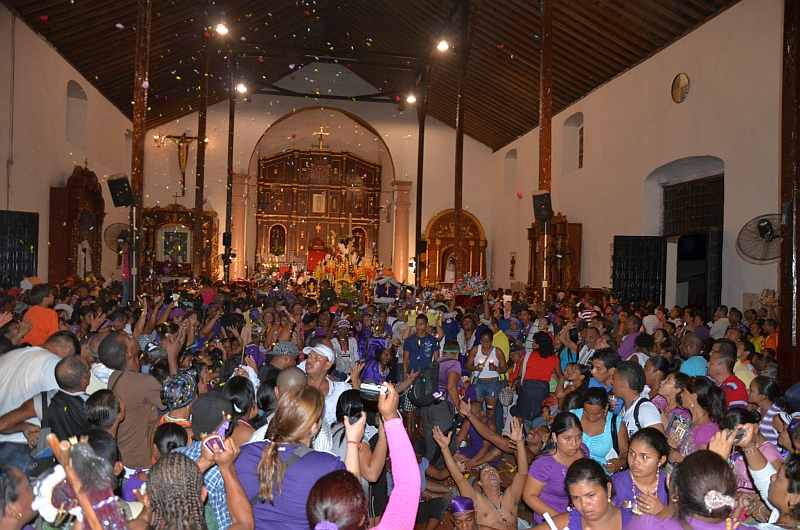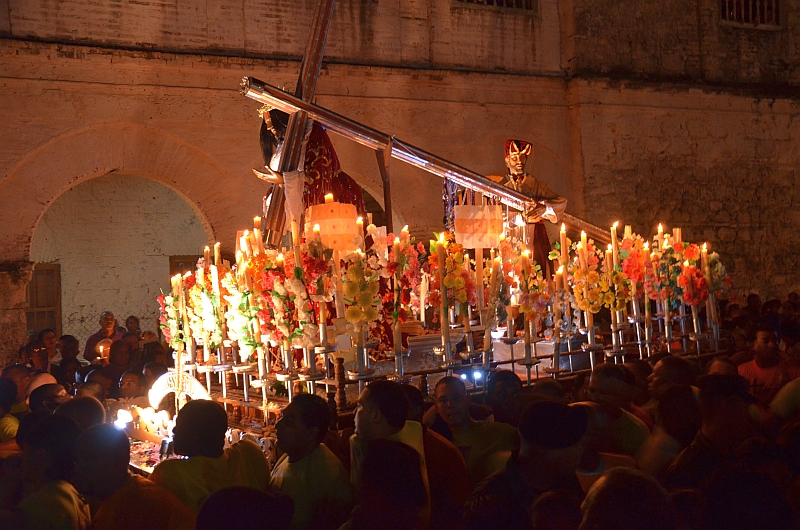The color : Violet
The music: Salsa
The odor: Grilled sausages.
The location : Portobelo, a small town on the Caribbean Sea. Some 2000 people live here. Three hostels offer some 60 bunk beds to unlikely tourists.
Today they are more then 20.000; they come here as pilgrims to worship the black Christ, El Cristo Negro. Most of them walked here from Colon, some 40 km away, some from Panama City. They arrive all night, tired, staggering. Some carry candles, others small replica of the Cristo Negro. Many of them wear long, violet dresses.
And then, there the others: Starting at the entrance of Portobelo, they cover the last km on all fours, kneeling or crawling on their back. In front of them, some relative, walking backwards, and waiving a statue or a picture of the Cristo Negro. Others, carrying candles, drop the burning wax on their bare backs. The pilgrims try to recover; redo a few meters after the statue, grimacing in pain, collapse again. Once they arrive on the front of the church of San Felipe, it becomes more dramatic. As if a mysterious power was pulling them back, they enter the church, retreat, grimace, shout , call the Christ for help: Naza! Naza! (Abbreviation for Cristo Nazareno). The crowd supports them: No hay dolor, no hay dolor (There is no pain) They enter again, step back, enter again until finally they collapse in front of the Black Christ. Then they shout their devotion to him, their misfortunes, their loyalty, and their wishes.
-----
Well, I am sorry, but I have the feeling that there is a lot on show involved in all this. As soon as they notice my camera, the grimacing, screaming and collapsing increases.
And then, there is that smell of sausages, the unbearable noise of samba music. I believe that it must be quite painful covering one km like this, but still… Actually I saw only one pilgrim who really walked the whole distance on his bleeding knees, all the others did not seem to have any injuries.
Back three years, in Lhasa, I assisted to the arrival of three young Tibetans who just came back from a three year long pilgrimage on their knees around Mount Kailash. Well, believe me, the burning flame in their eyes was different from the show that is offered here.
------------
This was yesterday evening, this morning and this afternoon.
Now, it is past midnight, I am just back from the closing ceremony, and I have changed my mind. There was no more salsa and even the smell of sausages was less disturbing. I had managed to squeeze into the San Felipe church to assist to the closing mass and the following procession through the streets of Portobelo. I had witnessed mass hysteria before, this was the second time. I do not want to fall into the trap, of the biggest, the most extraordinary etc, etc. But for sure this was one of the very strong experiences in my life. The religious fervor, the real one, I saw it tonight. This is Latin America, people express themselves differently from Europe. They show their feelings, sing and shout loud. At 8pm sharp, 80 strong men lifted the heavy platform with the black Christ, and, swaying to the rhythm of drums and trumpets, the procession started around Portobelo. The crowd chanted Viva el Cristo Negro, Viva el Naza! In front of the procession, those who earlier today crawled to the church, now carrying crosses and statues, walk backwards, swaying to the music, always the same: eight measures in a endless loop. Then comes the platform, the brass band and the huge crowd of pilgrims.
It did not rain today, a scorching head hang over Portobelo. Some people shout : Agua, Agua (Water!) And when the first raindrops for today started falling down, it was all that was needed to claim one more miracle. In the middle of the procession I spotted last pilgrims on their knees who were still arriving, but nobody is really watching them anymore. As a result, their behavior gets more natural, much less showlike.
In Echternach,Luxembourg there is the dancing procession, quite famous. It is even candidate to be recognized as World Cultural Heritage. But unlike in Echternach, where tradition has disappeared, here is still the real thing: The procession makes three steps forward, than two steps back. It took four hours to complete the 1 km lap around Portobello village.
-----
Nobody really knows where the Cristo Negro comes from. The legends around this statue are as numerous as the miracles attributed to Him. Generally people agree to say that it came from Spain, some 450 years ago. The rest is all myths and legends.
One of them says that a ship, trying to leave Portobelo with a heavy box could not leave the harbor. Five times the rough sea pushed it back, threatening men and ship. Finally, in order to save their lives, the crew threw the heavy box in the sea, and could leave. The box, containing the statue of the Christ, stranded on Portobelo beach, and was taken to the church by the inhabitants.
Another one tells that the statue was delivered here by mistake, but here again, the ship could not leave the harbor, being pushed back by the sea on every attempt. The people of Portobelo interpreted this as a divine sign, and concluded that the Cristo Negro wanted to stay in their village.

